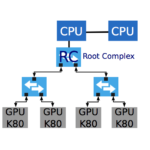At ISC 2019, Cray announced that CSCS in Switzerland is adding a third Cray CS-Storm supercomputer to support the development of cutting-edge weather service products at MeteoSwiss. “MeteoSwiss found success with its existing Cray supercomputers and selected this new CS-Storm to provide the additional computational power required to process increasing volumes of weather observations and produce higher fidelity forecasts. The CS-Storm system was also selected for its ability to run numerical weather forecasts within a reduced energy footprint (as compared to competing solutions), and for the reliability the platform provides MeteoSwiss when running critical workloads.”
GPUs Power Near-global Climate Simulation at 1 km Resolution
A new peer-reviewed paper is reportedly causing a stir in the climatology community. “The best hope for reducing long-standing global climate model biases, is through increasing the resolution to the kilometer scale. Here we present results from an ultra-high resolution non-hydrostatic climate model for a near-global setup running on the full Piz Daint supercomputer on 4888 GPUs.”
A PCIe Congestion-Aware Performance Model for Densely Populated Accelerator Servers
“MeteoSwiss, the Swiss national weather forecast institute, has selected densely populated accelerator servers as their primary system to compute weather forecast simulation. Servers with multiple accelerator devices that are primarily connected by a PCI-Express (PCIe) network achieve a significantly higher energy efficiency. Memory transfers between accelerators in such a system are subjected to PCIe arbitration policies. In this paper, we study the impact of PCIe topology and develop a congestion-aware performance model for PCIe communication. We present an algorithm for computing congestion factors of every communication in a congestion graph that characterizes the dynamic usage of network resources by an application.”
Swiss CSCS to Power Weather Forecasts with GPUs on Cray CS-Storm
Today Cray announced that the Swiss National Supercomputing Centre (CSCS) has installed a Cray CS-Storm cluster supercomputer to power the operational numerical weather forecasts run by the Swiss Federal Office of Meteorology and Climatology (MeteoSwiss). This is the first time a GPU-accelerated supercomputer has been used to run production numerical weather models for a major national weather service.







